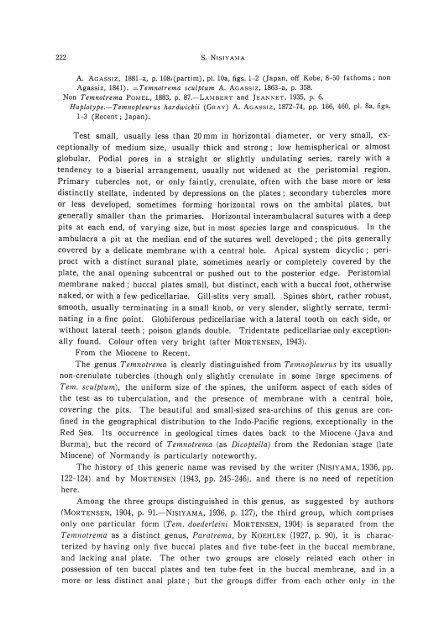the echinoid fauna from japan and adjacent regions part i
the echinoid fauna from japan and adjacent regions part i
the echinoid fauna from japan and adjacent regions part i
You also want an ePaper? Increase the reach of your titles
YUMPU automatically turns print PDFs into web optimized ePapers that Google loves.
222 s. NISIYAMA<br />
A. AGASSIZ, 1881-a, p. 108,(<strong>part</strong>im), pI. lOa, figs. 1-2 (Japan, off Kobe, 8-50 fathoms; non<br />
Agassiz, 1841). =Temnotrema sculptum A. AGASSIZ, 1863-a, p. 358.<br />
Non Temnotrema POMEL, 1883, p. 87.-LAMBERT <strong>and</strong> JEANNET, 1935, p. 6.<br />
Haplotype.-Temnopleurus hardwickii (GRAY) A. AGASSIZ, 1872-74, pp. 166, 460, pI. 8a, figs.<br />
1-3 (Recent; Japan).<br />
Test small, usually less than 20 mm in horizontal diameter, or very small, exceptionally<br />
of medium size, usually thick <strong>and</strong> strong; low hemispherical or almost<br />
globular. Podial pores in a straight or slightly undulating series, rarely with a<br />
tendency to a biserial arrangement, usually not widened at <strong>the</strong> peristomial region.<br />
Primary tubercles not, or only faintly, crenulate, often with <strong>the</strong> base more or less<br />
distinctly stellate, indented by depressions on <strong>the</strong> plates; secondary tubercles more<br />
or less developed, sometimes forming horizontal rows on <strong>the</strong> ambital plates, but<br />
generally smaller than <strong>the</strong> primaries. Horizontal interambulacral sutures with a deep<br />
pits at each end, of varying size, but in most species large <strong>and</strong> conspicuous. In <strong>the</strong><br />
ambulacra a pit at <strong>the</strong> median end of <strong>the</strong> sutures well developed; <strong>the</strong> pits generally<br />
covered by a delicate membrane with a central hole. Apical system dicyclic; periproct<br />
with a distinct suranal plate, sometimes nearly or completely covered by <strong>the</strong><br />
plate, <strong>the</strong> anal opening subcentral or pushed out to <strong>the</strong> posterior edge. Peristomial<br />
membrane naked; buccal plates small, but distinct, each with a buccal foot, o<strong>the</strong>rwise<br />
naked, or with a few pedicellariae. Gill-slits very small. Spines short, ra<strong>the</strong>r robust,<br />
smooth, usually terminating in a small knob, or very slender, slightly serrate, terminating<br />
in a fine point. Globiferous pedicellariae with a lateral tooth on each side, or<br />
without lateral teeth; poison gl<strong>and</strong>s double. Tridentate pedicellariae only exceptionally<br />
found. Colour often very bright (after MORTENSEN, 1943).<br />
From <strong>the</strong> Miocene to Recent.<br />
The genus Temnotrema is clearly distinguished <strong>from</strong> Temnopleurus by its usually<br />
non-crenulate tubercles (though only slightly crenulate in some large specimens of<br />
Tem. sculptum), <strong>the</strong> uniform size of <strong>the</strong> spines, <strong>the</strong> uniform aspect of each sides of<br />
<strong>the</strong> test as to tuberculation, <strong>and</strong> <strong>the</strong> presence of membrane with a central hole,<br />
covering <strong>the</strong> pits. The beautiful <strong>and</strong> small-sized sea-urchins of this genus are confined<br />
in <strong>the</strong> geographical distribution to <strong>the</strong> Indo-Pacific <strong>regions</strong>, exceptionally in <strong>the</strong><br />
Red Sea. Its occurrence in geological times dates back to <strong>the</strong> Miocene (Java <strong>and</strong><br />
Burma), but <strong>the</strong> record of Temnotrerna (as Dicoptella) <strong>from</strong> <strong>the</strong> Redonian stage (late<br />
Miocene) of Norm<strong>and</strong>y is <strong>part</strong>icularly noteworthy.<br />
The history of this generic name was revised by <strong>the</strong> writer (NISIY AMA, 1936, pp.<br />
122-124) <strong>and</strong> by MORTENSEN (1943, pp. 245-246), <strong>and</strong> <strong>the</strong>re is no need of repetition<br />
here.<br />
Among <strong>the</strong> three groups distinguished in this genus, as suggested by authors<br />
(MORTENSEN, 1904, p. 91.-NISIY AMA, 1936, p. 127), <strong>the</strong> third group, which comprises<br />
only one <strong>part</strong>icular form (Tern. doederleini MORTENSEN, 1904) is separated <strong>from</strong> <strong>the</strong><br />
Temnotrema as a distinct genus, Paratrema, by KOEHLER (1927, p. 90), it is characterized<br />
by having only five buccal plates <strong>and</strong> five tube-feet in <strong>the</strong> buccal membrane,<br />
<strong>and</strong> lacking anal plate. The o<strong>the</strong>r two groups are closely related each o<strong>the</strong>r in<br />
possession of ten buccal plates <strong>and</strong> ten tube-feet in <strong>the</strong> buccal membrane, <strong>and</strong> in a<br />
more or less distinct anal plate; but <strong>the</strong> groups differ <strong>from</strong> each o<strong>the</strong>r only in <strong>the</strong>












